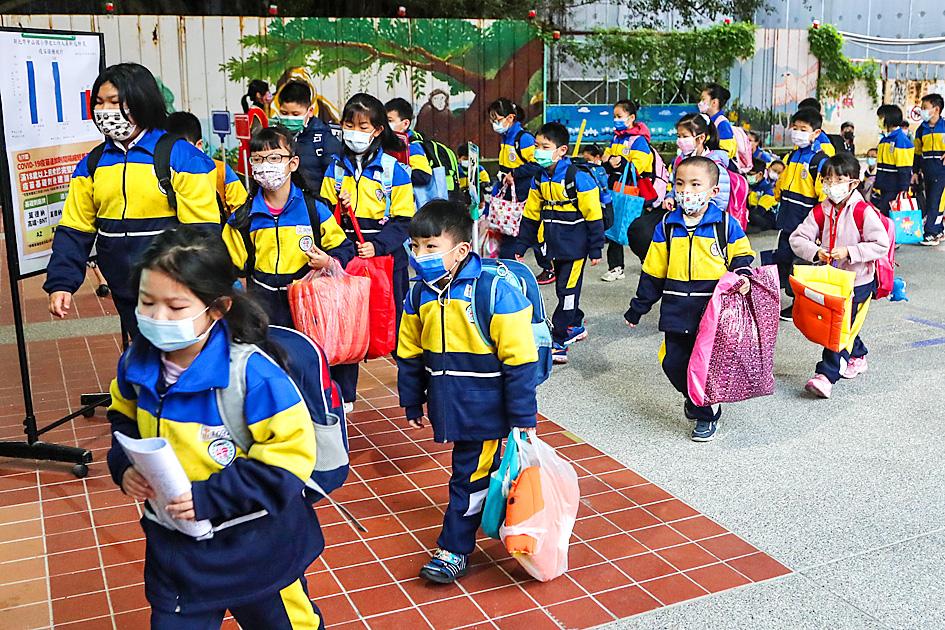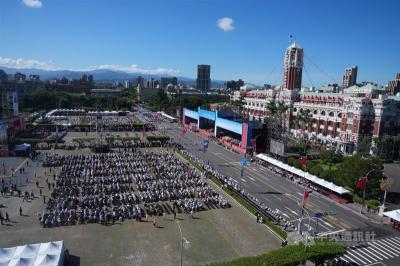The nation’s student population dropped to a new low of 4.17 million in the 2021 school year, 41,000 fewer than the previous school year, while the number of elementary schools with fewer than 100 students has reached a record 1,191, the latest Ministry of Education data showed.
The latest figure represented a drop of 332,000 students from the 2016 school year, the data showed.
Elementary-school students made up the largest group with 1.19 million, followed by vocational high-school students with 1.18 million.

Photo: CNA
Preschoolers, and junior-high school and high-school students accounted for a total of 1.74 million, the data showed.
The nation’s student population fell 1 percent from the previous school year. High schools and vocational high schools lost 24,000 students, a decline of 4 percent, over the period, the ministry data showed.
The number of college students decreased by 18,000, while the number of junior-high school students fell by 11,000 and that of preschoolers dropped by 1,000 from the previous school year, the data showed.
Compared with the 2016 school year, the number of elementary-school students fell by 32,000, or 7.4 percent, while the number of children enrolled in kindergartens rose by 89,000 over the past five years.
The number of schools — ranging from elementary to high-school level — with fewer than 100 students rose to 1,191, increasing by eight from the 2020 school year and rising by 152 from the 2016 school year.
Kindergartens are the most numerous kind of educational institution in the nation with 6,507 establishments, accounting for 42 percent of all educational institutions.
The number of kindergartens has been increasing at a rate of 60 establishments per year, the data showed.
The growth was mainly fueled by the opening of new public preschools. The government opened 365 public preschools over the past five years, while 168 private kindergartens closed down.
One public and four private elementary schools, two public and one private junior-high school, one private high school, and three private colleges and junior colleges closed down, the data showed.
Deputy Minister of Education Tsai Ching-hua (蔡清華) said the ministry is reducing the teacher-to-student ratio across all grades, while the K-12 Education Administration has established a task force to assist high schools with low enrollment numbers.
To better protect the education rights of children living in rural areas, local governments should consider opening classes comprising students of different ages at schools before merging or closing them, he said.
The ministry is adamant in its stance that schools must begin classes even if they have only one student.
The number of teachers across all school levels this school year is 31,000, 9,000 fewer than in the 2016 school year, while the number of preschool teachers has risen by 11,000, or 23.4 percent, the data showed.
Compared with 2015, the number of junior-high school teachers have decreased by 2,000 to 46,000, high-school teachers fell by 4,000 to 51,000, and the number of teachers at junior colleges and colleges dropped by 3,000 to 45,000.

The Ministry of the Interior (MOI) is to tighten rules for candidates running for public office, requiring them to declare that they do not hold a Chinese household registration or passport, and that they possess no other foreign citizenship. The requirement was set out in a draft amendment to the Enforcement Rules of the Public Officials Election and Recall Act (公職人員選舉罷免法 ) released by the ministry on Thursday. Under the proposal, candidates would need to make the declaration when submitting their registration forms, which would be published in the official election bulletin. The move follows the removal of several elected officials who were

The Republic of China (ROC) is celebrating its 114th Double Ten National Day today, featuring military parades and a variety of performances and speeches in front of the Presidential Office in Taipei. The Taiwan Taiko Association opened the celebrations with a 100-drummer performance, including young percussionists. As per tradition, an air force Mirage 2000 fighter jet flew over the Presidential Office as a part of the performance. The Honor Guards of the ROC and its marching band also heralded in a military parade. Students from Taichung's Shin Min High School then followed with a colorful performance using floral imagery to represent Taiwan's alternate name

FOUR DESIGNATED AREAS: Notices were issued for live-fire exercises in waters south and northwest of Penghu, northeast of Keelung and west of Kaohsiung, they said The military is planning three major annual exercises across the army, navy and air force this month, with the navy’s “Hai Chiang” (海強, “Sea Strong”) drills running from today through Thursday, the Ministry of National Defense said yesterday. The Hai Chiang exercise, which is to take place in waters surrounding Taiwan, would feature P-3C Orion maritime patrol aircraft and S-70C anti-submarine helicopters, the ministry said, adding that the drills aim to bolster the nation’s offshore defensive capabilities. China has intensified military and psychological pressure against Taiwan, repeatedly sending warplanes and vessels into areas near the nation’s air defense identification zone and across

A Chinese takeover of Taiwan would severely threaten the national security of the US, Japan, the Philippines and other nations, while global economic losses could reach US$10 trillion, National Security Council Deputy Secretary-General Lin Fei-fan (林飛帆) wrote in an article published yesterday in Foreign Affairs. “The future of Taiwan is not merely a regional concern; it is a test of whether the international order can withstand the pressure of authoritarian expansionism,” Lin wrote in the article titled “Taiwan’s Plan for Peace Through Strength — How Investments in Resilience Can Deter Beijing.” Chinese President Xi Jinping’s (習近平) intent to take Taiwan by force